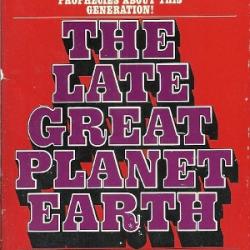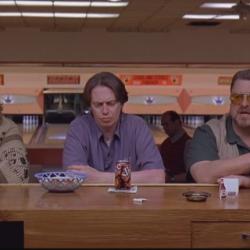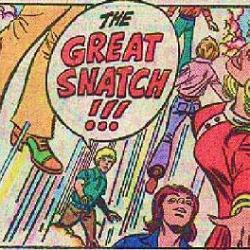Nicolae: The Rise of Antichrist, pp. 8-10
Today we deal with three pages. They involve at least two warheads exploding in American cities, yet they remain primarily preoccupied with traffic.
A traffic jam is presented as the primary obstacle facing our protagonists near Chicago, and traffic conditions are the only details provided in the report they hear of the perhaps-nuclear bombing of New York City.
We’ll get to that, but first let’s deal with the misogyny, because these three pages offer a condensed version of the gender stereotypes that pervade this entire series. More than anything else, what we encounter here is a contrast between Buck and Chloe — between man and woman, husband and wife, male and female.
The contrast is not subtle. The male is presented as heroic, resolute, resourceful, brave and take-charge. The female is presented as dependent, dithering, distracted, fearful and passive.
Here is what we read about Chloe in these pages:
Chloe snuggled close to him. “What do you mean ‘when we were first married’? We’re still newlyweds!”
… “Buck,” Chloe said, “our home. Where will we live?”
… It was like Chloe to worry about her home. … She had made their ridiculously expensive Fifth Avenue penthouse flat her own.
… “What are we going to do, Buck?”
… Chloe shrieked and buried her head in Buck’s chest.
… Chloe gasped … “What are you doing, Buck?” Chloe said.
Buck is given much, much more to say and to do. He’s in charge. He’s focused on the problem at hand and takes action to address it because he’s a manly man and that’s what manly men do.
And lest you doubt his manliness, Jerry Jenkins falls back on one of his favorite devices — the piloting of a powerful engine as a symbol of male virility:
Buck had never had patience for traffic jams, but this was ridiculous. His jaw tightened and his neck stiffened as his palms squeezed the wheel. The late-model car was a smooth ride, but inching along in near gridlock made the huge automotive power plant feel like a stallion that wanted to run free.
That has all the subtlety of an Extenze commercial. But the Extenze commercial is intentional, and therefore not nearly as funny.
Except this isn’t really funny either. Yes, at one level it’s hilarious — just look at the verbs in that paragraph: tightened, stiffened, squeezed, inching. Or the adjectives. And I don’t think any of that is deliberate or conscious. That stiffening as palms squeeze the smooth, huge stallion is the authors exposing themselves. Or, rather, it is the authors exposing the insecurities that underlie their patriarchal ideas about gender.
That insecurity is revealed at every step in these pages, as each of those helpless, shrieking questions of Chloe’s is countered by an assertion of Buck’s resolute, masculine know-how:
It was like Chloe to worry about her home. Buck was less concerned about that. He could live anywhere and seemed to have lived everywhere.
… “What are we going to do, Buck?”
Buck wished he knew what to say. He usually had an answer. Resourcefulness had been the trademark of his career. Regardless of the obstacle, he had somehow made do in every imaginable situation or venue in the world at one time or another.
… Chloe shrieked and buried her head in Buck’s chest. Buck scanned the horizon for what might have caused the concussion.
It seems the authors don’t know how to make Buck look brave except by making Chloe look frightened — or to make him look smart except by making her look dumb, or to make him look strong by making her look weak, or to make him seem big by making her look small. (And if that last one seems like an implied cheap shot or a bit of too-easy armchair psychiatry, re-read that amazing paragraph about Buck’s “huge automotive power plant.”)
It’s impossible to reconcile the portrayal of Chloe here with the very first thing we learned about her back in the first book. I’m sure I read more into it than the authors intended me too, but in our first glimpse of Chloe, she seemed impressive.
In the immediate aftermath of the Event, when the entire world was paralyzed with shock, chaos and grief, Chloe Steele, 20, somehow made her way from Stanford University to Mount Prospect, Ill. That’s about 2,200 miles, and Google maps says it would take a day and a half to drive it under optimal, non-apocalyptic conditions. That’s about what it took Chloe — at a time when no planes were flying, the railroads were shut down, the highways clogged with horrific accidents and driverless cars.
The authors didn’t explain how Chloe managed this, which somehow made it more impressive. She’s Chloe Steele — that’s how she did it and that is all you need to know.
I miss that Chloe — the smart, independent, omnicompetent young woman we thought we were meeting when she first showed up in Book 1. It’s a long way down from that initial appearance to this scene portraying Chloe as a helpless, shrieking, submissive little wife.
“Resourcefulness had been the trademark of his career,” we’re told here about Buck Williams. That, too, is difficult to reconcile with what we saw of Buck back in that same point of the first book. While Chloe was mysteriously skipping from Palo Alto to Chicago, it took Buck forever to get from Chicago to New York — this despite his having a massive expense account and the ability to charter a pilot. That expense account seems to be Buck’s idea of “resourcefulness” in a crisis.
A trademark of Jerry Jenkins’ career as a storyteller is his preference for telling over showing. It’s not just that he tends to tell readers one thing about his characters while showing them the opposite, but also that he doesn’t seem to realize that it matters quite a bit who is doing the telling.
These three pages heaping praise on Buck and belittling Chloe are presented from Buck’s point of view. It’s Buck Williams here who is praising himself. And it’s Buck Williams here who is making Chloe out to be a pathetic, whimpering, dependent child. Jenkins seems not to be aware that by presenting these opinions from Buck’s perspective he is inviting us to distrust, discount and disregard them. Or, rather, to disregard their face-value meaning and to reinterpret them in a way that accounts for Buck’s self-interest.
In other words, what Jenkins thinks he’s telling us is that Buck is a resourceful action hero while Chloe is a helpless little girl. But what he’s unintentionally signaling to us, instead, is that Buck is a pompous jerk who doesn’t respect his wife.
Brief detour here back to Creative Writing 101. Let’s say you’re writing a story with a character named Jim and you want your readers to regard Jim as brave. You can go about this in several different ways:
1. Show Jim doing something that requires bravery.
2. Have another character in your story describe Jim as brave.
3. Have the omniscient narrator of your story tell the reader that Jim is brave.
4. Have Jim tell the reader that Jim is brave.
Those are listed in order. The first is the most effective approach; the last is the least effective. The last one, in fact, can be counter-productive.
In these novels, Jenkins often goes with No. 4. He’s also fond of No. 2, but even then it comes across more like No. 4 because what we get is either Buck’s glowing praise of Rayford or Rayford’s glowing praise of Buck. That mutual admiration society lacks credibility because one gets the sense that what each character admires most about the other is that character’s reciprocal admiration for him.
Once again let me remind you that Jenkins charges $3,500 for the “Craftsmen” level writing courses offered by his “Christian Writer’s Guild,” but that those courses are only available to those who have successfully completed the $1,000 “Apprentice” and $1,280 “Journeyman” level courses.
I believe there’s a lot we can learn about writing from Jerry Jenkins, but not through those courses.
We haven’t yet discussed what actually happens in these three pages of Nicolae, so we’ll revisit them next week.












